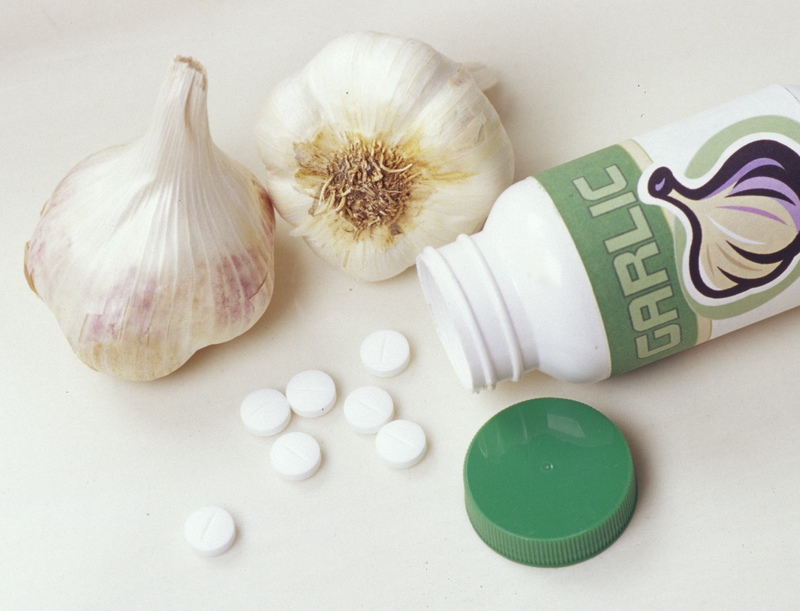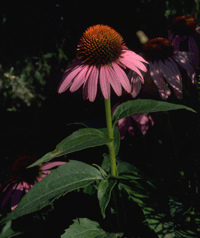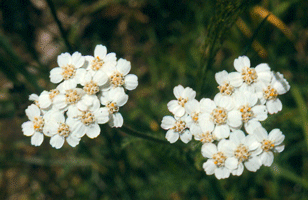Stay Informed
Popular Articles
- Hiatal Hernia: Hidden Cause of Chronic Illness
- Small Intestinal Bacterial Overgrowth (SIBO)
- Applied Lymphology: Unlocking the Secret to Pain Relief
- An Introduction to Constitutional Iridology
- The Low Down on Liver Detoxification
- An Energetic and Emotional Approach to Cancer
- Fat Facts
- Marrow in the Bones
- Blood Type and Nutrition
- Cardiac Herbs: Beyond Hawthorn
Quick Search
The School of Modern Herbal Medicine




A Comprehensive Approach to Infection
- 2/9/2008
This line of reasoning led me to a further realization. The herbal remedies that have been historically used to treat these kinds of infectious diseases nearly all have antimicrobial properties. However, their historical use is defined at least partly by their energetic properties (in other words, by how they affect biological terrain). So, I realized herbal remedies treat both the infection (that is, they act against the microbes directly) and they support the terrain by promoting better tissue health.
Unfortunately, modern medicine looks at only one side of the equation. Their entire focus is on “killing” the microbes. This bias tends to affect people's selection of herbal remedies as well. People are selecting remedies based on their antimicrobial properties (antiviral, antibacterial, antifungal) with no regard for how they affect terrain.
Using echinacea and goldenseal to treat a cold is a good example of this. The problem with selecting remedies this way is that they are only half as effective as they might otherwise be.
Think about this for a moment. In any placebo-controlled, double-blind study, patients with exactly the same disease are given either a placebo or the medication being tested. What researchers are looking for is a statistically significant improvement in a statistically significant number of patients. So, if 60% of the patients have a 40-60% improvement in comparison to the placebo, then the medicine has some “proof” behind it. But why didn't everyone respond? In my mind, science is supposed to be about consistent, duplicatable results. These results seem pretty “soft” to me and lack in a dependable, duplicatable accuracy.
Here's where traditional herbalism contains concepts which “come to the rescue,” so to speak. For hundreds, and in many cases thousands, of years, herbal healers have been asking the question, “What is different about the people who respond to this herb, versus those who respond to that herb?” In answering this question they have come up with various metaphorical systems based on energy. By assessing terrain-based factors in the patient, they have classified remedies both in how they affect pathology and how they affect terrain.
So, when you have an infectious process going on, the ideal thing is to “knock down” the microbes so their toxins will stop damaging healthy tissue and to restore balance to the terrain at the same time to prevent reoccurrence. With that understanding, I'm going to talk about some of my favorite antimicrobial herbs and how they affect the terrain—in other words, where they can be applied most effectively.
Garlic
 Crushed raw garlic has long been my favorite antimicrobial remedy, and when it comes to a direct substitute for antibiotics in fighting bacterial infection, I don't think anything is quite its equal. Fortunately, unlike antibiotics, it also works on viral infections and because it is antifungal, it won't contribute to yeast overgrowth, one of the major side effects of antibiotics.
Crushed raw garlic has long been my favorite antimicrobial remedy, and when it comes to a direct substitute for antibiotics in fighting bacterial infection, I don't think anything is quite its equal. Fortunately, unlike antibiotics, it also works on viral infections and because it is antifungal, it won't contribute to yeast overgrowth, one of the major side effects of antibiotics.
Garlic is a pungent remedy, however, which means it is strongly heating and has a drying effect, too. Pungent herbs disperse energy to the surface of the body (the skin and mucus membranes), which increases the discharge of toxins. Garlic's primary affinity, however, is for the lungsÄÂso its best application is for infections in the lungs. Its secondary affinity is for the digestive tract, but I have not found it to be as effective at intestinal infections (such as the flu) as it is at respiratory infections (like pneumonia).
Because garlic is so heating and drying, it generally doesn't work as well for people who tend to be hot and dry constitutionally. It “overheats” them. So, the patient who tends to have a ruddy (reddish) complexion, tends to run a “hot” metabolism, sweats easily and is more aggressive will probably not find garlic as effective as a person with a cooler temperament. Garlic is best suited to people with a “phlegmatic” constitution, one that tends to run colder, with paler skin, chills easily and has a tendency to chronic sinus congestion. If you look at someone's tongue and there is a thick, white, moist coating on it, then garlic would probably be helpful. If the tongue is bright red, garlic will probably be less effective. Garlic is not the best choice for high fevers, either, although I have successfully used garlic enemas for fevers in children.
As I mentioned, crushed, raw garlic has the strongest effect. Garlic oil also has a lot of antimicrobial effect. NSP's High Potency Garlic comes in third, and powdered garlic in capsules and odorless garlic products are dead last, being nearly worthless in fighting infection.
Goldenseal
My mother used to put goldenseal on canker sores when I was little and I hated the stuff, but nowadays, it's one of my favorite herbal remedies. Goldenseal is one of a number of herbs (including Oregon grape, barberry, coptis, yellow root and several others) that contain berberine alkaloids. These alkaloids have a decent antibacterial action, although they are not as potent at directly killing bacteria as garlic. Each of these remedies is subtly different from the others as berberine is not the only “active” compound in them.
Goldenseal is touted in some herbals, such as Back to Eden, as a virtual “cure-all,” but I was often disappointed in its actions until I learned its more specific energetics. Now, I can use it more accurately and get better results.
I've already mentioned that goldenseal is bitter. It also has an underlying astringent quality. Goldenseal is a “cooling” remedy, not a “heating” remedy like garlic. Whereas garlic disperses, goldenseal consolidates, toning membranes and helping to arrest discharge. The bitter nature of goldenseal means it is also drying, but bitters tend to move energy downward through the liver, colon and kidneys, rather than dispersing energy outward through the skin and membranes. Goldenseal primarily acts on mucus membranes, and works best in cases of subacute inflammation on membranes.
If you look at someone's tongue and they have a thick, yellowish coating on their tongue, goldenseal may be a good remedy. It is a good choice for chronic sinus infection, with thick, yellowish mucus, chronic digestive tract infections with loose stools (like giardia) and chronic urinary tract infections with painful, burning urination. For urinary tract infections, however, it is best when combined with other urinary herbs as goldenseal's primary affinity is for the digestive tract, and secondarily for the respiratory tract.
Echinacea
 A recent study tested echinacea's effectiveness against colds and came up with a very negative result. There are some controversies around the study, particularly regarding the quantity of the herb administered, but the results don't surprise me--I've never found echinacea that helpful for colds. Yes, echinacea is antiviral, but terrain-wise, the common cold is rarely the ideal setting to test echinacea's full potential.
A recent study tested echinacea's effectiveness against colds and came up with a very negative result. There are some controversies around the study, particularly regarding the quantity of the herb administered, but the results don't surprise me--I've never found echinacea that helpful for colds. Yes, echinacea is antiviral, but terrain-wise, the common cold is rarely the ideal setting to test echinacea's full potential.
Like goldenseal, echinacea is a bitter, which means it is cooling and drying. echinacea angustifolia is also acrid, which gives it a burning, tingling sensation similar to lobelia. This cooling action means it is not the best choice for the early stages of a respiratory infection where there is thin, watery mucus or copious white mucus.
In fact, using echinacea for colds is a fairly modern use, as traditionally it was used for serious bacterial infections and snakebites. Echinacea's primary affinity is not for the respiratory or digestive tracts, but for the blood and lymph. It fights infections that have gone beyond the “surface” of the skin and mucus membranes and have entered the blood. In fact, an ideal indication for echinacea is blood poisoning. If you've ever seen a wound with red streaks moving away from it, you're looking at a very serious bacterial infection that is spreading through the blood stream. Echinacea is an excellent remedy for this type of infection.
Echinacea inhibits the enzymes secreted by bacteria to break down connective tissue so they can spread. In effect, echinacea inhibits the “forest fire” of the infection from spreading. It creates containment and then stimulates the immune factors in the blood to “mop up” the bacteria in the contained area. So, echinacea is ideal for localized infections with acute swelling and inflammation, such as sore throats, tonsillitis and infected, swollen lymph nodes.
The popular combination of goldenseal and echinacea is a very good remedy for lingering, low-grade infections that the body is having a hard time shaking. So, if you have a cold that you didn't quite recover from that is lingering a week later, this blend is a good option.
Yarrow
 Earlier, I mentioned that I didn't think garlic was the best option for fevers. Well, yarrow is. Yarrow is at once aromatic, bitter and astringent. Its odd mix of energetic qualities make it suitable for a wide range of applications, depending on how it is prepared and administered. Because it is aromatic, yarrow, like garlic, is dispersing--meaning it helps to flush toxins out of the skin and mucus membranes. However, the bitterness and astringency of yarrow mean that it is also cooling, rather than heating, so it relieves heat and irritation at the same time. Like echinacea, yarrow works on the deep level of the blood, rather than the superficial level of the skin and membranes.
Earlier, I mentioned that I didn't think garlic was the best option for fevers. Well, yarrow is. Yarrow is at once aromatic, bitter and astringent. Its odd mix of energetic qualities make it suitable for a wide range of applications, depending on how it is prepared and administered. Because it is aromatic, yarrow, like garlic, is dispersing--meaning it helps to flush toxins out of the skin and mucus membranes. However, the bitterness and astringency of yarrow mean that it is also cooling, rather than heating, so it relieves heat and irritation at the same time. Like echinacea, yarrow works on the deep level of the blood, rather than the superficial level of the skin and membranes.
These qualities make yarrow flowers my favorite remedy for feverish conditions or infections where the tongue is red and pointed, an indication of acute “heat” in the system. In my experience, yarrow does this best when taken in liquid form. It does not seem to have quite as much potency in capsule form. A strong infusion made from the flowers is the most potent way to use this medicine, but it tastes terrible. When I first tried it many years ago I could barely gag it down. Now, I know that combining it with elderflowers and peppermint results in a much more pleasant-tasting, but still effective remedy. I dubbed this blend “children's composition” and now use it as a glycerin extract, which is a very effective remedy for acute viral infections.
Besides helping to bring down acute fevers, “children's composition” (which works for adults, too) also works well in the very early stages of a cold where there is thin, watery mucus that burns the nose and upper lip. The cooling, but dispersing, action of yarrow helps flush the irritants while at the same time cooling and soothing the heat. This blend is a cornerstone of my “Dr. Mom-Dr. Dad” system for treating children.
Other Remedies
The five remedies listed above are the primary single-herb, remedies I've used to fight infection in my family. However, there are a few others I'd like to mention.
Myrrh
This one is a pretty good antimicrobial agent. It was used to embalm bodies anciently, so it obviously inhibits a wide variety of microbes. It is both aromatic and bitter and appears to work best on mucus membranes and skin.
Uva Ursi
Here we have a very specific agent that works almost exclusively on the urinary tract. It's one of my favorite remedies for urinary tract infections. I find it works best as a tea. Drink about 1/2 to 1 cup per day of a tea made with 3-4 capsules of uva ursi per cup of boiling water. This remedy is astringent, so it is cooling and drying.
Essential Oils
A number of essential oils are very good antimicrobial agents, including tea tree oil, thyme and oregano. All of these substances make wonderful topical antiseptics, but should be used with caution internally as they are extremely potent. Because they are essential oils, they are heating and drying and have a dispersing energy, making them good for “cold” and “damp” conditions and infections on the skin and membranes, but are not the best choices for deeper infections in the blood and lymph.
These oils can be diffused into the air to prevent the spread of microbes. They can also be applied topically in massage lotions or in baths and are very effective when used in this manner. I have rubbed massage oil made with disinfectant oils into swollen lymph nodes or other infected body parts with great success. This is also the safest way to use them.
Oregon Grape
Like goldenseal, oregon grape contains berberine alkaloids, but it has more affinity for the liver and lymphatics and less affinity for the digestive tract and mucus membranes. I find that Oregon grape is a better “blood purifier” than goldenseal and is very good at clearing up infections that involve the skin like chicken pox and measles.
Olive Leaf Extract
I'm not real sure of the energetics on this one. It contains elenolic acid that is anti-microbial and useful against colds, flu, upper respiratory and sinus infections.
Wild Indigo (Baptista)
This is a remedy I learned about from David Winston. It is for very serious, deep-seated infection where there is putrefaction. He says that there is a smell of decaying meat associated with these types of infections. Baptista combines really well with echinacea to treat these kinds of serious septic conditions, but it is unlikely you'll have clients with this kind of problem since they will probably be treated by a doctor if they have an infection this bad.
Lomatium
This is an antiviral agent that I've had some success with. It's in the carrot family and has worked on some serious, deep-seated viral conditions that I couldn't get other remedies to touch.
Honey
Applied topically, honey can completely halt the growth of all the major wound-infecting species of bacteria as well as fungal infections. If you mix some honey with a little bit of essential oil, you have a very effective antimicrobial dressing for wounds.
Colloidal Silver (Silver Shield)
Colloidal silver is not an herb or even a nutritional supplement. It is a suspension of silver that are small enough to be absorbed into the body. Silver was used as a germicide and an antibiotic before modern antibiotics were developed. In previous centuries, users would shave silver particles into their drinking water, or submerge whole silver pieces in the drinking water. The practice of eating with silver utensils (i.e., silverware) may have resulted from a belief in the healthful properties of silver.
Unlike antibiotics, silver is effective against bacteria, viruses and fungus and will not target beneficial bacteria of the gastrointestinal or female reproductive tract. I'm not sure how I would classify the energetics of silver as a remedy, but it seems to be “cooling” in nature. It is definitely not warming. It probably works best in inflammatory situations.
I use a patented silver product sold under the trade name Silver Shield, which is EPA registered as completely non-toxic. It works in very small doses and uses only the finest particle-size colloids to ensure maximum efficiency. It will not cause argyria, a blue/gray discoloration of the skin that happens when someone takes too much colloidal silver. This patented product was found to be both bacteriostatic and bactericidal for all organisms tested with equal or broader spectrum than the antibiotics it was tested against.
I hope this information has given you a better idea of where and how to use various antiseptic and antibiotic substances. I still believe our primary objective should be to balance the terrain, but, like Ed Millet taught me, you sometimes have to stop the “forest fire” of the infection, too.
Selected References
Colloidal Silver by Robert J. Holladay, Herbert Christensen, William D. Moeller, US Patent 7135195 (2003)
Principles and Practice of Phytotherapy by Simon Mill and Kerry Bone
Herbal Defense by Robyn Landis
Prescription for Natural Healing by James F. Balch and Phyllis A. Balch
The Encyclopedia of Medicinal Plants by Andrew Chevallier
The Rise of Antibiotic-Resistant Infections by Ricki Lewis, Ph.D.
